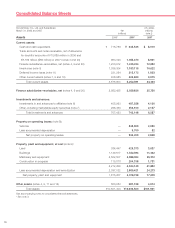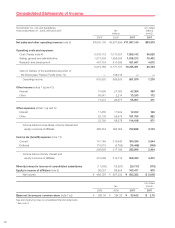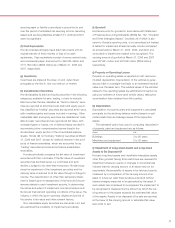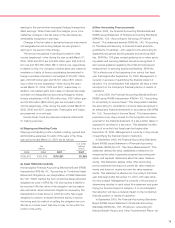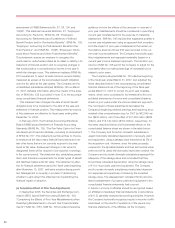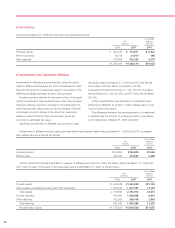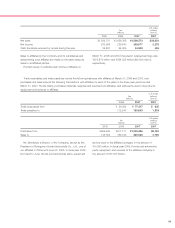Honda 2007 Annual Report Download - page 81
Download and view the complete annual report
Please find page 81 of the 2007 Honda annual report below. You can navigate through the pages in the report by either clicking on the pages listed below, or by using the keyword search tool below to find specific information within the annual report.
79
earnings in the period when forecasted hedged transactions
affect earnings. When these cash flow hedges prove to be
ineffective, changes in the fair value of the derivatives are
immediately recognized in earnings.
Changes in the fair value of derivative financial instruments
not designated as accounting hedges are recognized in
earnings in the period of the change.
The amount recognized in earnings included in other
income (expenses)—other during the year ended March 31,
2005, 2006 and 2007 are ¥44,905 million gain, ¥55,516 mil-
lion loss and ¥48,485 million ($411 million) loss, respectively.
In relation to this, the Company included gains and losses on
translation of debts of finance subsidiaries denominated in
foreign currencies intended to be hedged of ¥10,667 million
gain, ¥45,046 million gain and ¥8,351 million ($71 million)
loss in other income (expenses)—other during the years
ended March 31, 2005, 2006 and 2007, respectively. In
addition, net realized gains and losses on interest rate swap
contracts not designated as accounting hedges by mainly
finance subsidiaries of ¥28,000 million loss, ¥827 million gain
and ¥3,309 million ($28 million) gain are included in other
income (expenses)—other during the years ended March 31,
2005, 2006 and 2007, respectively. These gains and losses
are presented on a net basis.
Honda doesn’t hold any derivative financial instruments
for trading purposes.
(r) Shipping and Handling Costs
Shipping and handling costs included in selling, general and
administrative expenses for each of the years in the three-
year period ended March 31, 2007 are as follows:
U.S. dollars
Yen (millions)
(millions) (note 2)
2005 2006 2007 2007
¥159,472 ¥181,675 ¥219,361 $1,858
(s) Asset Retirement Liability
Honda applies Financial Accounting Standards Board (FASB)
Interpretation (FIN) No. 47, “Accounting for Conditional Asset
Retirement Obligations—an interpretation of FASB Statement
No.143”. FIN47 clarifies the term conditional asset retirement
obligation as used in SFAS No.143 and requires a liability to
be recorded if the fair value of the obligation can be reason-
ably estimated. Asset retirement obligations covered by this
Interpretation include those for which an entity has a legal
obligation to perform an asset retirement activity, however
the timing and (or) method of settling the obligation are con-
ditional on a future event that may or may not be within the
control of the entity.
(t) New Accounting Pronouncements
In March 2006, the Financial Accounting Standards Board
(FASB) issued Statement of Financial Accounting Standards
(SFAS) No. 156, “Accounting for Servicing of Financial
Assets”. This statement amends SFAS No. 140, “Accounting
for Transfers and Servicing of Financial Assets and Extin-
guishments of Liabilities”, with respect to the accounting for
separately recognized servicing assets and servicing liabili-
ties. SFAS No. 156 gives revised guidance as to when servic-
ing assets and servicing liabilities should be recognized. It
also revises guidance regarding the initial and subsequent
measurement of servicing assets and liabilities. SFAS No.
156 is effective as of the beginning of an entity’s first fiscal
year that begins after September 15, 2006. Management is
currently in process of quantifying the financial impact of
adoption. It is not anticipated that adoption will have a mate-
rial impact on the Company’s financial position or results of
operations.
In June 2006, the Financial Accounting Standards Board
(FASB) issued FASB Interpretation (FIN) No. 48, “Accounting
for Uncertainty in Income Taxes”. This Interpretation clarifies
the accounting for uncertainty in income taxes recognized in
an enterprise’s financial statements in accordance with SFAS
No. 109, “Accounting for Income Taxes”. This Interpretation
prescribes a two step process for the recognition and mea-
surement in the financial statement of a tax position taken or
expected to be taken in a tax return. This statement is effec-
tive as of an entity’s first fiscal year that begins after
December 15, 2006. Management is currently in the process
of quantifying the financial impact of adoption.
In September 2006, the Financial Accounting Standards
Board (FASB) issued Statement of Financial Accounting
Standards (SFAS) No.157, “Fair Value Measurements”. This
statement defines fair value, establishes a framework for
measuring fair value in generally accepted accounting prin-
ciples, and expands disclosures about fair value measure-
ments. This Statement applies under other accounting
pronouncements that require or permit fair value measure-
ments and does not require any new fair value measure-
ments. This statement is effective as of an entity’s first fiscal
year that begins after November 15, 2007, with early adop-
tion encouraged. Management is currently in the process of
determining whether to early adopt this statement and quan-
tifying the financial impact of adoption. It is not anticipated
that adoption will have a material impact on the Company’s
financial position or results of operation.
In September 2006, the Financial Accounting Standards
Board (FASB) issued Statement of Financial Accounting
Standards (SFAS) No. 158, “Employers’ Accounting for
Defined Benefit Pension and Other Postretirement Plans—an



